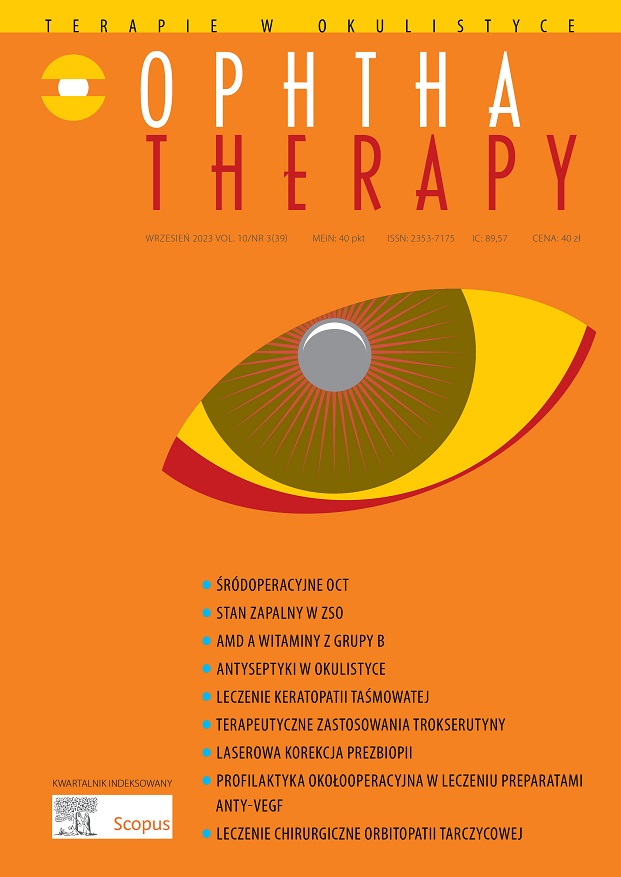Zaostrzenia stanu zapalnego w zespole suchego oka Artykuł przeglądowy
##plugins.themes.bootstrap3.article.main##
Abstrakt
Zespół suchego oka jest schorzeniem, którego leczeniem zajmuje się niemal każdy okulista. Najnowsze doniesienia zwracają uwagę na nieznane dotychczas składowe choroby. Są to tzw. flares, czyli zaostrzenia stanu zapalnego. Powstają one w odpowiedzi na czynniki wyzwalające – środowiskowe lub wewnętrzne. Podczas flares są wyzwalane elementy odpowiedzi immunologicznej, co skutkuje zaostrzeniem subiektywnych objawów odczuwanych przez pacjenta. W łagodzeniu dolegliwości skuteczna okazuje się terapia przeciwzapalna, w tym miejscowe leczenie kroplami z hydrokortyzonem.
Pobrania
##plugins.themes.bootstrap3.article.details##

Utwór dostępny jest na licencji Creative Commons Uznanie autorstwa – Użycie niekomercyjne – Bez utworów zależnych 4.0 Międzynarodowe.
Copyright: © Medical Education sp. z o.o. License allowing third parties to copy and redistribute the material in any medium or format and to remix, transform, and build upon the material, provided the original work is properly cited and states its license.
Address reprint requests to: Medical Education, Marcin Kuźma (marcin.kuzma@mededu.pl)
Bibliografia
2. Tsubota K, Pflugfelder SC, Liu Z et al. Defining dry eye from a clinical perspective. Int J Mol Sci. 2020; 21. http://doi.org/10.3390/ijms21239271.
3. Pflugfelder SC, de Paiva CS. The pathophysiology of dry eye disease: what we know and future directions for research. Ophthalmology. 2017; 124: S4-s13. http://doi.org/10.1016/j.ophtha.2017.07.010.
4. Bron AJ, de Paiva CS, Chauhan SK et al. TFOS DEWS II pathophysiology report. Ocul Surf. 2017; 15: 438-510. http://doi.org/10.1016/j.jtos.2017.05.011.
5. Zhang X, Qu Y, He X et al. Dry eye management: targeting the ocular surface microenvironment. Int J Mol Sci. 2017; 18(7): 1398. http://doi.org/10.3390/ijms18071398.
6. Yamaguchi T. Inflammatory response in dry eye. Invest Ophthalmol Vis Sci. 2018; 59: DES192-D199. http://doi.org/10.1167/iovs.17-23651.
7.Rolando M, Zierhut M, Barabino S. Should we reconsider the classification of patients with dry eye disease?[published online November 12, 2019]. Ocul Immunol Inflamm. 2019. http://doi.org/10.1080/09273948.2019.1682618.
8. Perez VL, Stern ME, Pflugfelder SC. Inflammatory basis for dry eye disease flares. Exp Eye Res. 2020; 201: 108294. http://doi.org/10.1016/j.exer.2020.108294.
9. Cutolo CA, Barabino S, Bonzano C et al. The use of topical corticosteroids for treatment of dry eye syndrome. Ocul Immunol Inflamm. 2019; 27(2): 266-75. http://doi.org/10.1080/09273948.2017.1341988.
10. Haber SL, Benson V, Buckway CJ et al. Lifitegrast: a novel drug for patients with dry eye disease. Ther Adv Ophthalmol. 2019; 11: 2515841419870366. http://doi.org/10.1177/2515841419870366.
11. Hamard H, Schmitt C, Plazonnet B et al. Study of the ocular penetration of dexamethasone. [Etude de la pénétration oculaire de la déxamethasone.] In: Demailly P, Hamard H, Luton JP (ed). Oeil et cortisone. Masson, Paris 1975: 33-84.
12. McGhee CN. Pharmacokinetics of ophthalmic corticosteroids. Br J Ophthalmol. 1992; 76(11): 681-4. http://doi.org/10.1136/bjo.76.11.681.
13. Kallab M, Szegedi S, Hommer N et al. Topical Low Dose Preservative-Free Hydrocortisone Reduces Signs and Symptoms in Patients with Chronic Dry Eye: A Randomized Clinical Trial. Adv Ther. 2020; 37(1): 329-41. http://doi.org/10.1007/s12325-019-01137-8.
14.Kuzmanović Elabjer B, Marković L, Bjeloš M et al. A Retrospective Data Review Confirms That Topical Preservative-Free Hydrocortisone Improves Inflammation in Dry Eye Disease. Clin Ophthalmol. 2020; 14: 3691-7. http://doi.org/10.2147/OPTH.S283655.
15. Filippelli M, dell’Omo R, Gelso A et al. Effects of topical low-dose preservative-free hydrocortisone on intraocular pressure in patients affected by ocular surface disease with and without glaucoma. Graefes Arch Clin Exp Ophthalmol. 2022; 260(1): 247-53.

